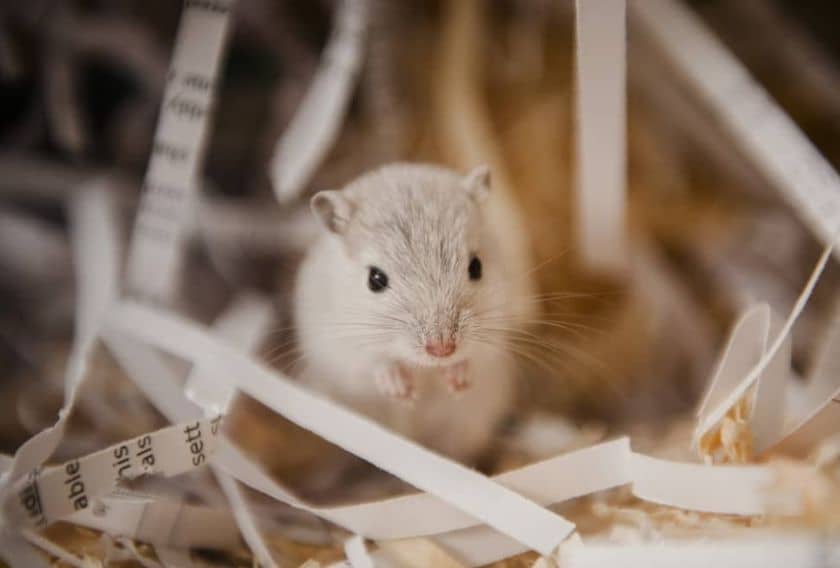The Pet Fancy Rats are popular pets because they are curious, intelligent, clean, friendly, and trainable.
The Fancy Rat (Rattus Norvegicus domestica) is a domesticated rodent that is popular with many names such as Common Rat, Brown Rat, Sewer Rat, Hanover Rat, Norwegian Rat, and Wharf Rat.
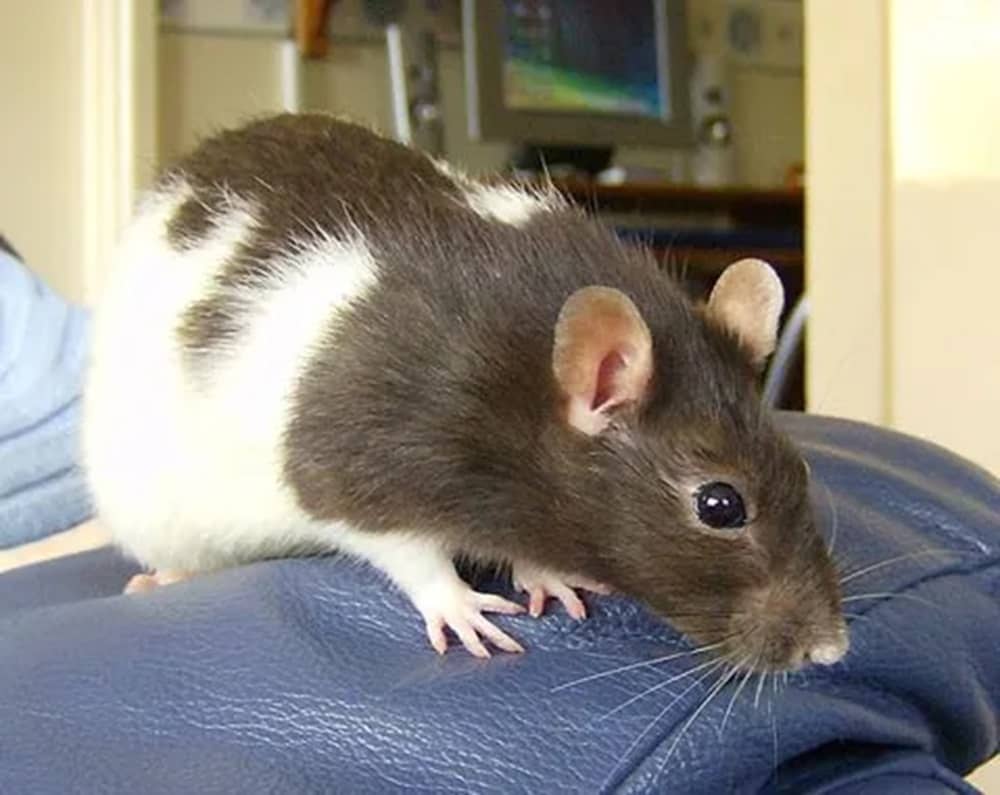
The two varieties of Fancy Rats are the Black Rat(Rattus Rattus) and the Brown Rat(Rattus Norvegians). These are popular pets known for their curious and friendly nature.
It is a pocket pet species artificially bred in a variety of colors and coat patterns, adding to their appeal. They come in colors of white, cinnamon, blue, black, beige, fawn, and chocolate. The agouti coloring rats have three tones of colors on the same hair.
Pet Fancy Rat – Different Varieties And Not Breeds
As all rats are Rattus Norvegicus, these are known as varieties and not breeds. With selective breeding, a large range of different fancy rats such as Satin, Dumbo, Manx rat, and Siamese Fancy rat are developed with variations in their physical attributes such as fur color, eye color, markings, coat type, hairless, and body types. Some of the common varieties of Pet Fancy Rats are:
Standard:
Standard Fancy rats have a normal, full coat of fur that is soft and dense. Their ears are positioned on top of their heads, and they typically have a sleek, well-proportioned body.
Tailless:
Tailless rats are born without tails or with very short tails due to a genetic mutation. This mutation can sometimes affect their balance and agility, as rats normally use their tails for balance.
Rex:
Rex rats have curly, crimped fur and whiskers due to a genetic mutation. Their coats can vary in thickness, but the distinctive curliness is a hallmark of the Rex variety.
Hairless:
Hairless rats, as the name suggests, have little to no fur. They may have some sparse whiskers and sometimes a thin layer of downy fur. They require special care to keep their skin healthy and protected.
Satin:
Satin rats have a unique, shiny coat that appears glossy and reflective due to the structure of their hair shafts. Their fur can feel silkier than that of standard rats.
Dumbo:
Dumbo rats are characterized by their large, round ears that are positioned on the sides of their heads rather than on top, giving them a distinct appearance reminiscent of the Disney character, Dumbo.
Bristle coat:
Bristle Coat rats have a rougher, coarser texture to their fur compared to standard rats. Their coats are often described as feeling bristly or spiky.
Siamese:
It has a beige base coat with gradual blending towards the nose and feet. Siamese rats have a distinct coloration similar to Siamese cats. They typically have a lighter body color with darker points (ears, nose, feet, and tail base). Their fur color can darken with age or changes in temperature.
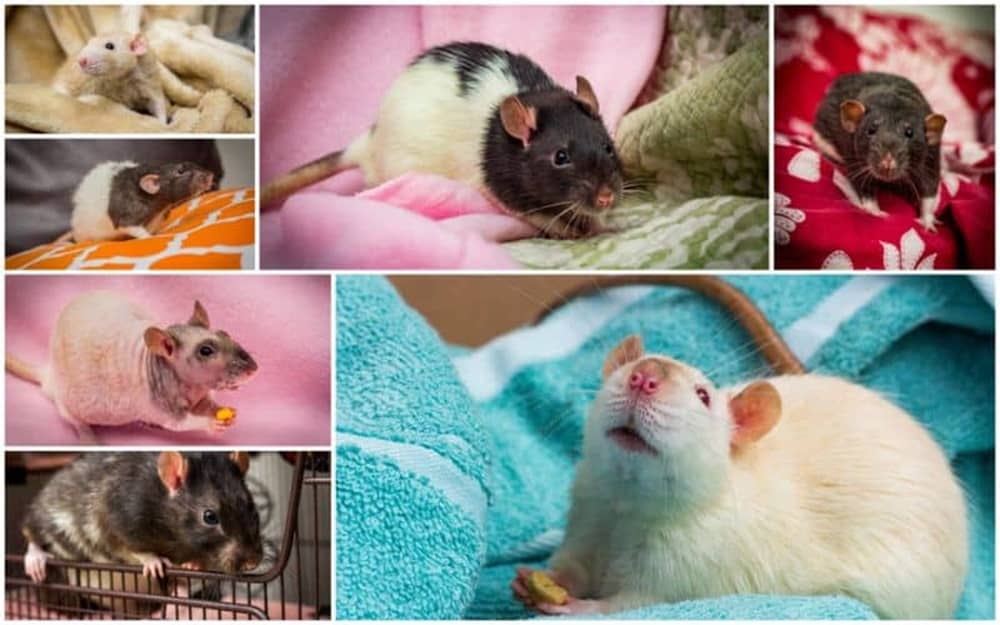
These tiny creatures are lovable and relatively easy to care for, making them ideal for pet enthusiasts of all ages.
Size Information And Life Expectancy
Fancy Rat typically measures around 9-11” or 23 to 28cm in body length, with a tail that is roughly of the length 7-9” or 8-23cm. The weight of females is around 200-400g and that of male is in between 250-400g. The life expectancy is nearly 2-3 years.
They are known for their social nature and high intelligence. They are affordable, loyal, affectionate, and easily trained. Fancy Rat makes delightful pets for those willing to dedicate time and effort to their care. The breeders arrange shows to display the color, body shape, and behavior of their Fancy Rat.
Pet Fancy Rat Behavior and Temperament
The Fancy Rat is a highly social creature and forms close bonds with other Fancy Rat and owners that are playful and curious fellows who need social interaction to keep themselves busy. They are non-aggressive, robust, and inquisitive in nature and will hop from one point to another and enjoy petting, rubbing around their face, and cuddling. It is better to keep same-sex Fancy Rats in the cage to nurture their social instincts.

Fancy Rats are highly social, intelligent, and playful and enjoy interaction with humans and other rats. The pet rats enjoy exploring their environment and interacting with their owners.
They can be trained to perform tricks, come when called, and even use a litter box. Their social nature means they thrive in pairs or groups, and keeping them alone can lead to loneliness and behavioral issues.
Male Vs Female Pet Fancy Rat
The male Fancy rat is known as Buck and the female as Does and their babies are called pups. Though both male and female rats are friendly and make great pets but there are some point of difference in terms of their body weight, size, and behavior.
Males:
The male Fancy rats are generally larger and bulkier than females.
Often more laid back and affectionate, making them great lap pets. They tend to be more docile and less active than females. Male rats can develop a noticeable scent due to their sebaceous glands, which can be managed with regular cage cleaning and a proper diet.They have a coarse coat.They attain sexual maturity in 6-10 week duration.
Females:
The female Fancy rats are smaller and more agile compared to males. Typically more active, curious, and playful. They enjoy exploring and may require more stimulation and toys. These are less likely to have a strong odor compared to males. The female rats attain sexual maturity in 8-12 weeks duration.
Ethics and Legality
In the USA, keeping Fancy Rats as pets is legal and generally considered ethical, provided they are well cared for. Ethical breeding practices are crucial to ensure the health and well-being of these animals. It’s important to adopt from reputable breeders or rescues to avoid supporting unethical breeding practices that can lead to health issues and poor temperament in rats.
How to Care for a Pet Fancy Rat?
Providing proper care for a Fancy Rat involves ensuring that they have a stimulating environment, a balanced diet, regular exercise, and veterinary check ups.
Housing
A Fancy Rat is an energetic creature so you should provide spacious enclosures with plenty of room for exercise and enrichment. A large wire cage with multiple levels is preferred over glass or plastic enclosures as these are poorly ventilated.
The floor should be solid either of metal or of plastic. Bucks being very big and Does very active, a rat of either sex needs a lot of space. Therefore the size of the cage should be around 2.5 cubic feet per rat, the bigger the better.

The rats are sensitive to significant fluctuations in temperature. Therefore you should maintain around 65-80 degrees Fahrenheit of temperature and nearly 40-60% humidity.
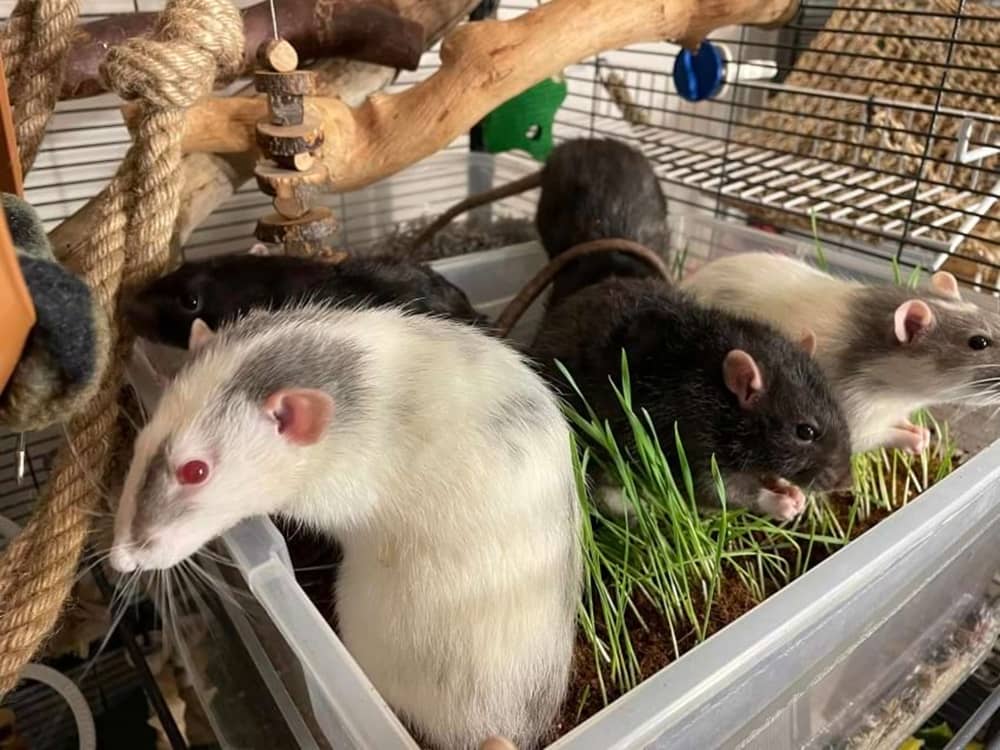
The fancy rats are Escape artists and therefore bar spacing should not be more than 0.5” to prevent escapes. You should create multiple levels with hammocks, tunnels, and hiding spots that are important to keep rats stimulated and active.
Specific Substrate Requirements
The bedding should be nearly 0.5-1” deep to provide comfortable and cozy bedding to your Fancy Rat. You can set up the bedding with a particular material such as Fleece fabric, recycled newspaper, and shredded paper.Avoid using cedar or pine shavings, as they can be toxic to their respiratory systems. Use a dust-free, absorbent substrate to maintain hygiene and reduce respiratory issues. Aspen shavings or paper-based bedding are ideal.
Nest Box
It is better to provide appropriate nesting material, such as paper tissues or recycled autoclaved paper pulp products to pet fancy rats. Good quality hay, shredded paper, tissue paper, paper towels, and cardboard are convenient choices for nesting material.

You should not use cotton wool or similar bedding products as the strands of cotton get struck in their legs and pose a serious risk to their health.
Chew Toys
A Fancy Rat has overgrowing teeth, therefore you should provide chew sticks and toys for gnawing.
Exercise Wheel and Tunnel Tube
The Fancy Rat love to keep themselves busy by hopping from one point to another in their cage. You can provide an exercise wheel to roll and enjoy. They explore every corner of their cage and wander through tunnels and ladders.

The accessories such as tunnels, wheels, and hiding places for enrichment keep your little friend happy in captivity.
Food Bowl and Water Bottle
A ceramic food tray and a water bottle should be kept inside the enclosure. The water bottle should have a metal tube with a chew guard.
Other Points of Consideration For setting up enclosure
- It should be well-ventilated with a temperature range of nearly 20 degrees Celsius.
- You should regularly spot-clean the enclosure.
- After Cleaning put some used but unsoiled nesting and bedding material back into the enclosure to give them a familiar scent.
- Never house them with hamsters, gerbils, or guinea pigs as they are prone to get infections.
- Thorough cage cleaning is required every week. You should rinse the toys, food tray, and other stuff to keep the environment hygienic.
It’s a good idea to encourage natural foraging behavior, as rats enjoy holding and manipulating food in their paws.
What Does A Fancy Rat Eat and Drink?
A Fancy Rat is an omnivore therefore you can supplement their diet with a variety of seeds, grains, cooked eggs, fruits, vegetables, and meat.
Balanced Diet
A balanced diet of high-quality lab blocks or pellets specifically formulated for rats is a good option to feed your fancy rat.
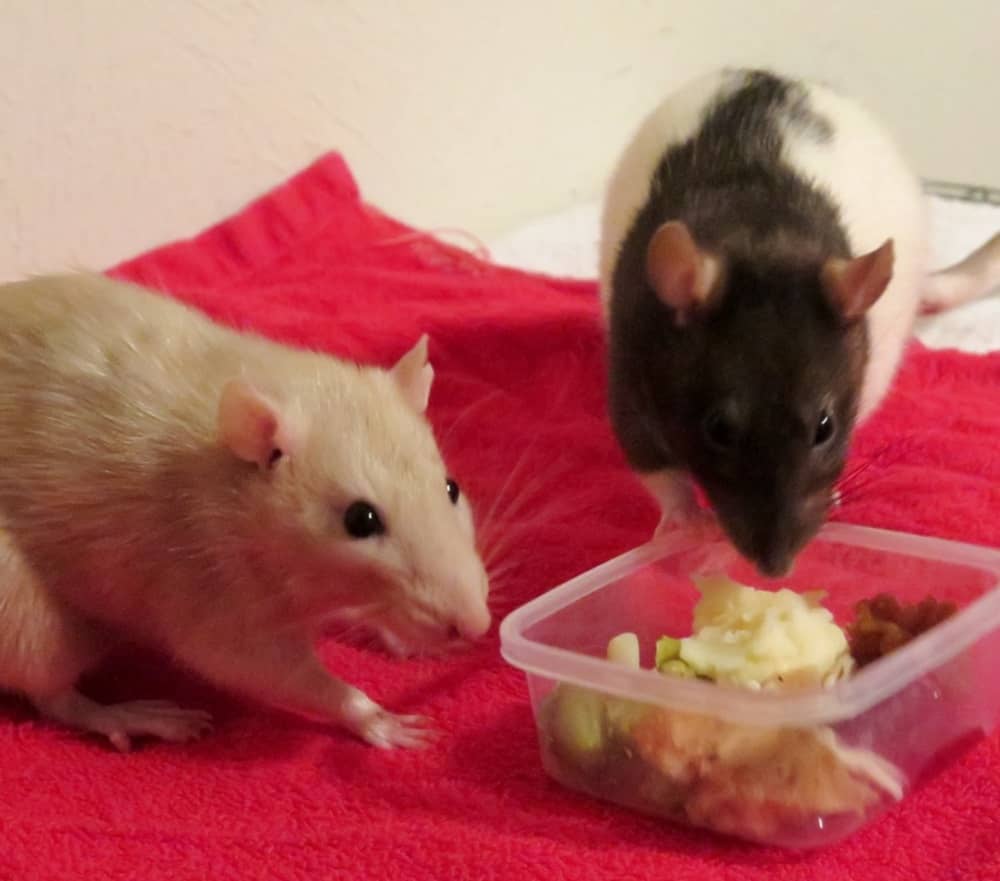
You should not give citrus fruits (especially for males), blue cheese, raw beans, carbonated drinks, and chocolate as these are toxic for them.The fancy rat also shows coprophagy or fecal reingestion just like rabbits. It helps them to get nutrients and keep their digestive system healthy.

Drinking Water
You should provide access to clean drinking water in a water bottle with a metal tube. It would be better if more water bottles are kept in the enclosure as all the rats can drink water simultaneously.

Change the water in the water bottle on alternate days and check for any bacterial or mold growth in the water bottle.
Handling Of A Pet Fancy Rat
The Fancy Rat is an adorable pet and amenable to human touch. Spending time with your pet rat will give you a better idea about its nature and temperament. It would be better if you start training your Fancy Rat for human contact by handling on daily basis for a short duration and with the help of small treats. This will help them to build trust in you.
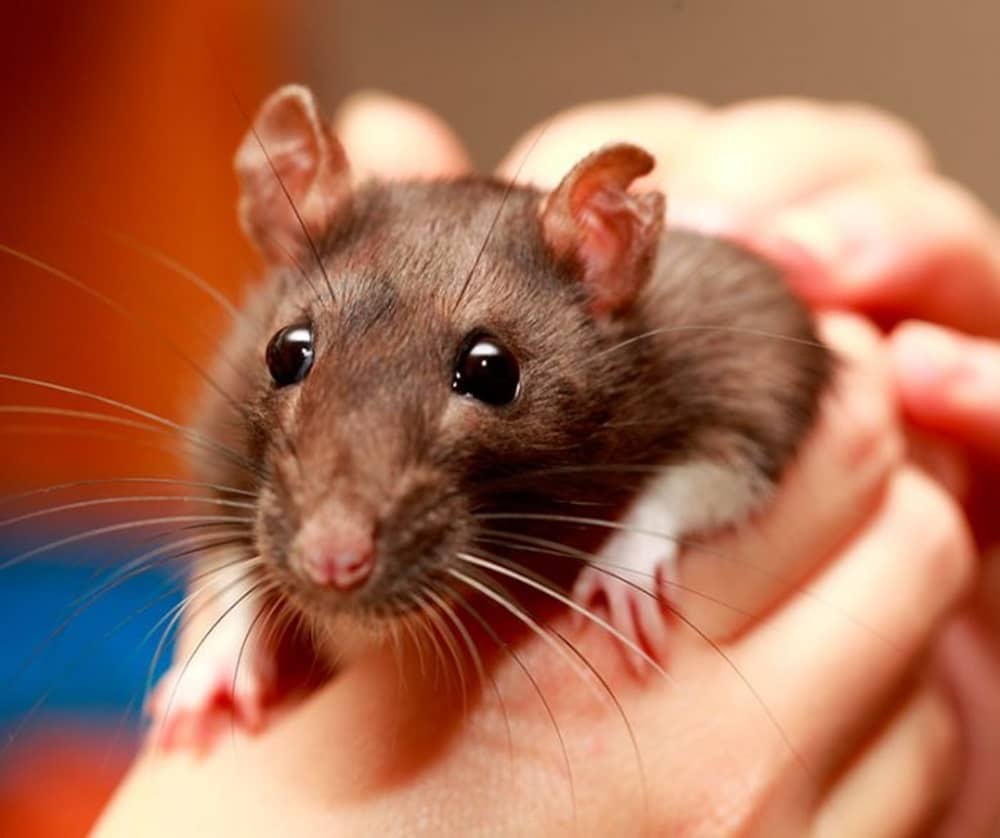
Be Patient
When you bring a rat at home, give it some time to acclimatize to a new environment.
How to Pick Your Rat?
You should always approach them calmly and avoid sudden movements. One hand should be placed confidently yet gently behind the front legs. Support their body when picking them up and hold them close to your chest or on your lap.
After lifting, take the rat into your arms and use the other hand to support its rear end. You should never attempt to pick up rats by their tails as this may cause injury
Let them come to you
Climbing and perching on your arms and shoulders will be more pleasurable and soothing for your rats than being held. After developing a strong link with their owner, young or adult rats may frequently be highly curious and will approach the cage door or wait on the edge of their hammocks to greet you.
Common Health Problems in Pet Fancy Rat
1 Mammary Tumors:
The Fancy Rat are susceptible to developing tumors in their body. Females may develop breast cancer and older Fancy Rats can suffer from leukemia and lymphoma. The reason that Fancy Rat, as well as many other small animals, get ill easier is due to their genomes containing more viruses
2. Bumble Foot:
Bumblefoot is a very painful condition that causes red swelling and ulcers on the bottom of the Fancy Rat’s feet.
3. Mouth and Dental Problems:
Uneven incisor tooth wear, bruxism, pawing at the mouth, incapacity to gnaw, incisor tooth overgrowth (78.3%), and mobile molar teeth (4.3%) were among the clinical symptoms displayed by individual Fancy Rat who were not yet officially diagnosed.
4. Skin Conditions: Rats can get skin parasites, such as lice. The changes to the fur such as the formation of bald patches or lumps are indications of ill health.
5. Respiratory Infections: Respiratory infections are often caused by poor ventilation or dusty bedding. It can be indicated if your rat is sneezing, wheezing, or find difficulty in breathing.
Other problems
There can be other health issues such as loss of appetite, fatigue and feebleness, and adhesion on the bottom. Regular veterinary checkups and a nutritious diet can help prevent many health problems.
Exercise
Regular exercise is essential for keeping your Fancy Rat healthy and happy. You should provide opportunities for your pet to run, jump, and play outside of their cage in a safe and supervised environment. Supervised time outside the cage is important for mental and physical stimulation.
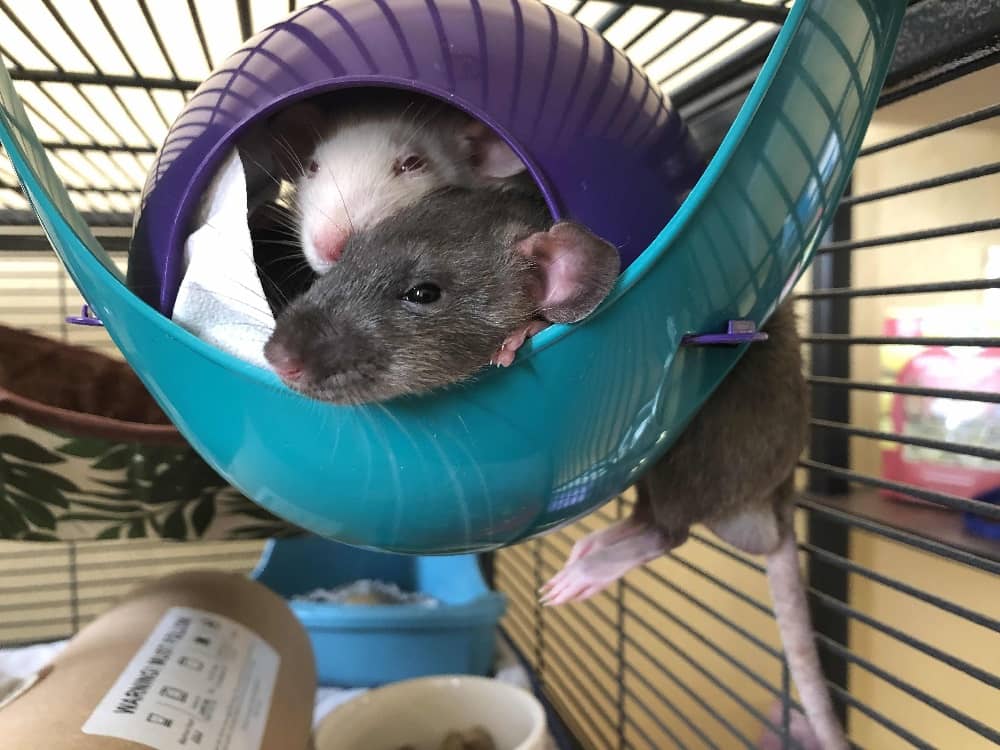
Keeping a pair of Fancy Rat is preferred over keeping a single. Fancy Rats enjoy running behind each other. Exercise wheels and toys designed for small rodents are also great options for keeping your Fancy Rat active. Create a safe play area where they can explore and exercise.
Grooming
The Fancy Rat does not require any special grooming. The Fancy Rat are self-groomed living beings and clean their mates if kept together in group.
Do Pet Fancy Rats Need Bathing?
You can occasionally bathe your fancy rat to maintain hygiene but you should not take normal shampoo for human use. You can take a mild shampoo that is animal-friendly. Avoid fully bathing your rats unnecessarily as they may find water stressful. You can use a wet paper towel or sponge to clean a particular area, for instance, tail cleaning of your rat.
Please take care not to over bathe your rat as this will deplete the natural oils and cause the skin to dry. Keeping the bath time short and soothing your rat will help to minimize stress.
Nail Trimming
The nails of the pet rat need occasional trimming.
Teeth Trimming
The front teeth of Fancy Rat keep on growing therefore chewy materials like wood chews, mineral chews, and chew tubes are a must in its habitat.
Where to Buy a Fancy Rat?
You can buy a pet Fancy Rat from a local pet store or adopt it from a rescue team. Before bringing it to your home, you should enquire about its gender, age, and well-being. You can also check on these links for getting the Fancy Rat.
Pet-Smart : The website provides detailed information on each pet, including care instructions, habitat setup, and dietary needs. Additionally, PetSmart offers various related products such as cages, bedding, and food to ensure the well-being of your new pet.
Upkeep Cost
The cost of caring for a Fancy Rat includes expenses such as food, bedding, veterinary care, and occasional cage upgrades. On average, you may expect to spend around $20 to $30 per month on their food, bedding, and basic supplies.
Moreover, regular checkups and emergency visits can cost $50 to 100 per visit. Pet insurance may be a consideration for some owners.
Pros and Cons of Keeping Fancy Rat as a Pet
Fancy Rats are delightful creatures known for their intelligence and affectionate nature making them adorable pets but there are some drawbacks that you should know before bringing them home.
Pros:
- The Fancy Rats are sociable and intelligent creatures therefore they make enjoyable companions. They enjoy interacting with their human caregivers.
- Fancy Rats are highly intelligent and can be trained to perform tricks and use a litter box.
- As low grooming is required and diet is also not so expensive as compared to other pets like dogs or cats, therefore upkeep cost is also low.
- These can be tamed at an early age. Their fascinating behaviors and fun-loving nature provide entertainment for owners.
- They are inexpensive and easy to care for pets.
- They are extremely clean creatures and have a pleasant smell.
- They do not require care like a dog, such as daily walk, vaccinations and grooming.
Cons:
- Fancy Rat requires a significant time investment for socialization and care.
- They can be prone to health problems if not provided with a proper diet and environment.
- They carry viruses and bacteria which can be transmitted to humans.
- They have a short lifespan of 2 to 3 years only.
- They are voracious chewers so you may need to make your home rat-proof.
- They may require veterinarian assistance and it may be difficult to find an affordable one in your vicinity.
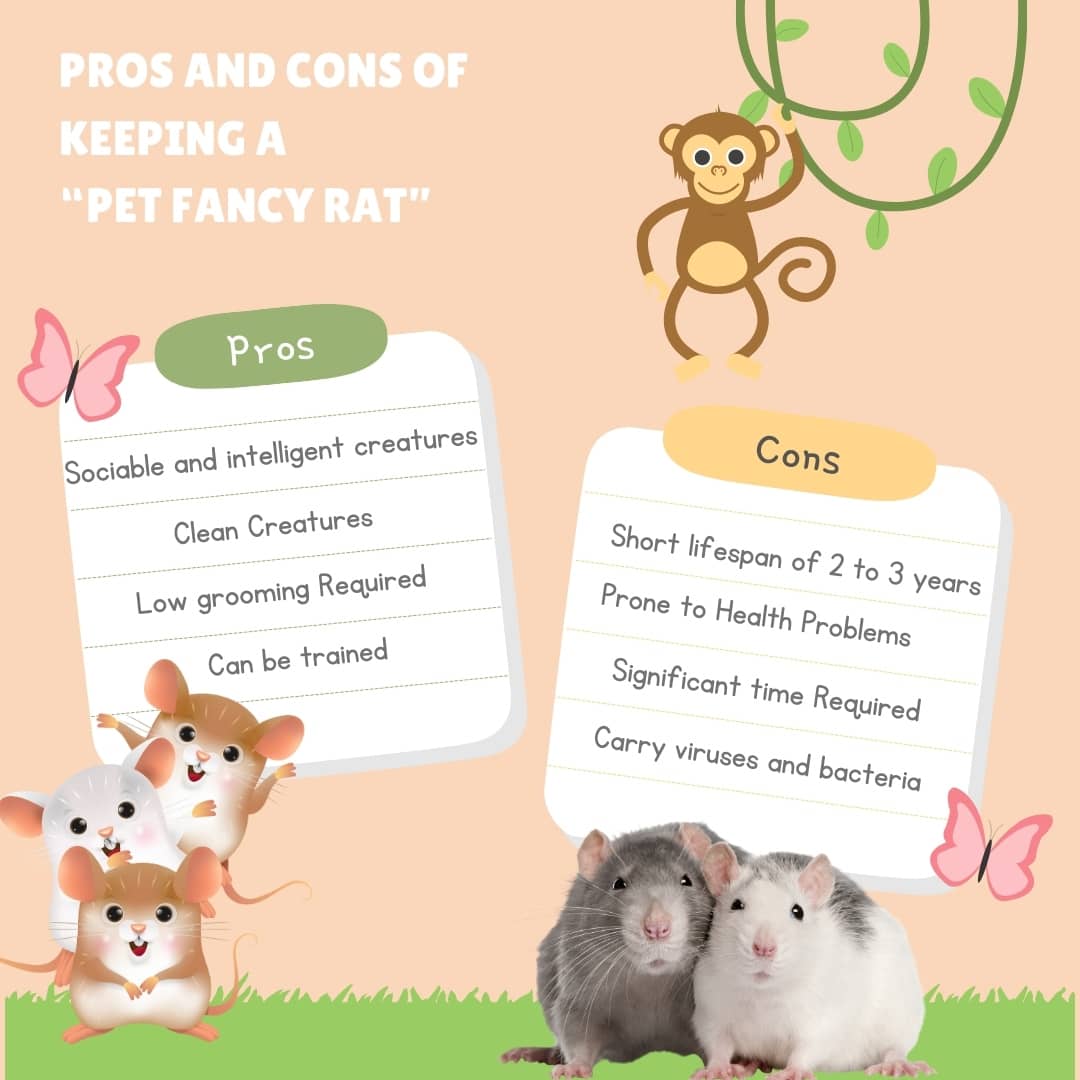
Similar Pets
Frequently Asked Questions
Question1. Are Fancy Rats good pets for children?
Answer: Fancy Rats can make excellent pets for older children and make great bonds with each other. They rarely bite and are safe companions of children.
Question2. Do Fancy Rats like to be held or are they cuddly?
Answer: They love being picked up, prefer to climb on you and love scritches on the head and belly.
Question 3: Can Fancy Rat be litter trained?
Answer: Fancy rats are clean pets and prefer to use litter boxes rather than making everything messy. They can be trained for the same with patience.
Question 4: Which rat is the most friendliest?
Answer: The Dumbo Burmese is the most friendly rat amongst other varieties of pet rats.
Question 5: Are fancy rats hard to take care of?
Answer: Fancy Rats are not low maintenance as they need a continuous food supply and chewing material. These are prone to health problems, especially dental problems, and need a visit to a veterinarian for trimming.
Question 6: Are Fancy Rats prone to any health problems?
Answer: Fancy Rat can be prone to dental problems, skin infections, tumors, and respiratory infections if not properly cared for.
Question 7:What is the difference between Wild rats and Fancy pet rats?
Answer: The Wild rats are comparatively aggressive as compared to pet rats. They have Brown, grey and Black colorations only.

Question 8: How to set up the cage for a Fancy Rat?
Answer: The cage of a fancy rat needs appropriate bedding material, a food bowl, a drinking water bottle, a litter box, and toys for physical and mental stimulation.
Question 9: How big does Fancy Rat get?
Answer: A Fancy Rat takes up a size of nearly 23-28cm.
Question 10: Can I give Fancy rat a bath?
Answer: The Fancy rats are clean pets and can be given occasional baths using a mild shampoo or a dog shampoo.
Interesting Facts About Fancy Rat
- Name Recognition: Fancy Rats can recognize their names and respond when called.
- Problem Solving Skills: They have excellent problem-solving abilities and can navigate mazes and puzzles.
- Communication: Rats communicate with each other using ultrasonic sounds that are inaudible to humans.
- Rat Baiting: Rats were used for a sport called “Rat Baiting”.
- Acute Hearing: Fancy Rats have acute hearing and a well-developed sense of taste and smell.
- Friendliest variety: The Dumbo Burmese rats are the most friendliest variety of rats.
- Peculiar Behaviors: When fancy rats feel frisky they bound across the floor known as ” popcorning“. When they feel contented, they grind their teeth- “Bruxing” and when they are super happy, their eyes bulge out “Boggling”.
- Grooming Habits: They groom themselves and each other frequently, maintaining cleanliness and social bonds. They enjoy being petted and brushed.
- Adaptable Schedules: While naturally nocturnal, rats can adapt to their owner’s schedule and be active during the day.
- Teeth Growth: Their teeth never stop growing, requiring constant gnawing to keep them in check.
- Social Hierarchy: Rats establish a social hierarchy within their groups, which can influence their behavior and interactions.
- Swimming Ability: Rats can swim and often enjoy playing in water under supervision.
- Lifespan: Fancy Rats typically have a lifespan of 2 to 3 years.
- Litter Training: They can be trained to use a litter box, making cage maintenance easier.
- Female Aggression: Females go into heat for 24 hours every 4-5 days once. They reach puberty and may seen agitated during this time.



